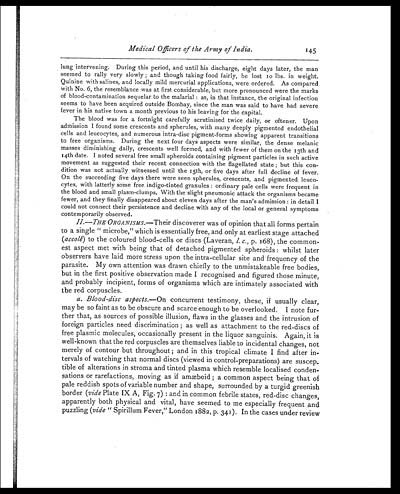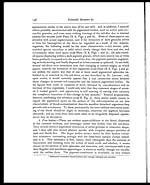Medicine - Institutions > Army health reports and medical documents > Scientific memoirs by medical officers of the Army of India > Part III, 1887 > 10 - Note on some aspects and relations of the blood-organisms in ague
(151) Page 145
Download files
Individual page:
Thumbnail gallery: Grid view | List view

Medical Officers of the Army of India.
145
lung intervening. During this period, and until his discharge, eight days later, the man
seemed to rally very slowly; and though taking food fairly, he lost 10 lbs. in weight.
Quinine with salines, and locally mild mercurial applications, were ordered. As compared
With No. 6, the resemblance was at first considerable, but more pronounced were the marks
of blood-contamination sequelar to the malarial: as, in that instance, the original infection
seems to have been acquired outside Bombay, since the man was said to have had severe
fever in his native town a month previous to his leaving for the capital.
The blood was for a fortnight carefully scrutinised twice daily, or oftener. Upon
admission I found some crescents and spherules, with many deeply pigmented endothelial
cells and leucocytes, and numerous intra-disc pigment-forms showing apparent transitions
to free organisms. During the next four days aspects were similar, the dense melanic
masses diminishing daily, crescents well formed, and with fewer of them on the 13th and
14th date. I noted several free small spheroids containing pigment particles in such active
movement as suggested their recent connection with the flagellated state; but this con-
dition was not actually witnessed until the 15th, or five days after full decline of fever.
On the succeeding five days there were seen spherules, crescents, and pigmented leuco-
cytes, with latterly some free indigo-tinted granules: ordinary pale cells were frequent in
the blood and small plasm-clumps. With the slight pneumonic attack the organisms became
fewer, and they finally disappeared about eleven days after the man's admission: in detail I
could not connect their persistence and decline with any of the local or general symptoms
contemporarily observed.
II.—THE ORGANISMS.— Their discoverer was of opinion that all forms pertain
to a single " microbe," which is essentially free, and only at earliest stage attached
(accolé) to the coloured blood-cells or discs (Laveran, l. c., p. 168), the common-
est aspect met with being that of detached pigmented spheroids: whilst later
observers have laid more stress upon the intra-cellular site and frequency of the
parasite. My own attention was drawn chiefly to the unmistakeable free bodies,
but in the first positive observation made I recognised and figured those minute,
and probably incipient, forms of organisms which are intimately associated with
the red corpuscles.
a. Blood-disc aspects.— On concurrent testimony, these, if usually clear,
may be so faint as to be obscure and scarce enough to be overlooked. I note fur-
ther that, as sources of possible illusion, flaws in the glasses and the intrusion of
foreign particles need discrimination; as well as attachment to the red-discs of
free plasmic molecules, occasionally present in the liquor sanguinis. Again, it is
well-known that the red corpuscles are themselves liable to incidental changes, not
merely of contour but throughout; and in this tropical climate I find after in-
tervals of watching that normal discs (viewed in control-preparations) are suscep-
tible of alterations in stroma and tinted plasma which resemble localised conden-
sations or rarefactions, moving as if amæboid; a common aspect being that of
pale reddish spots of variable number and shape, surrounded by a turgid greenish
border (vide Plate IX A, Fig. 7): and in common febrile states, red-disc changes,
apparently both physical and vital, have seemed to me especially frequent and
puzzling (vide " Spirillum Fever," London 1882, p. 341). In the cases under review
Set display mode to: Large image | Zoom image | Transcription
Images and transcriptions on this page, including medium image downloads, may be used under the Creative Commons Attribution 4.0 International Licence unless otherwise stated. ![]()
| Permanent URL | https://digital.nls.uk/75004459 |
|---|
| Shelfmark | IP/QB.10 |
|---|---|
| Additional NLS resources: | |




